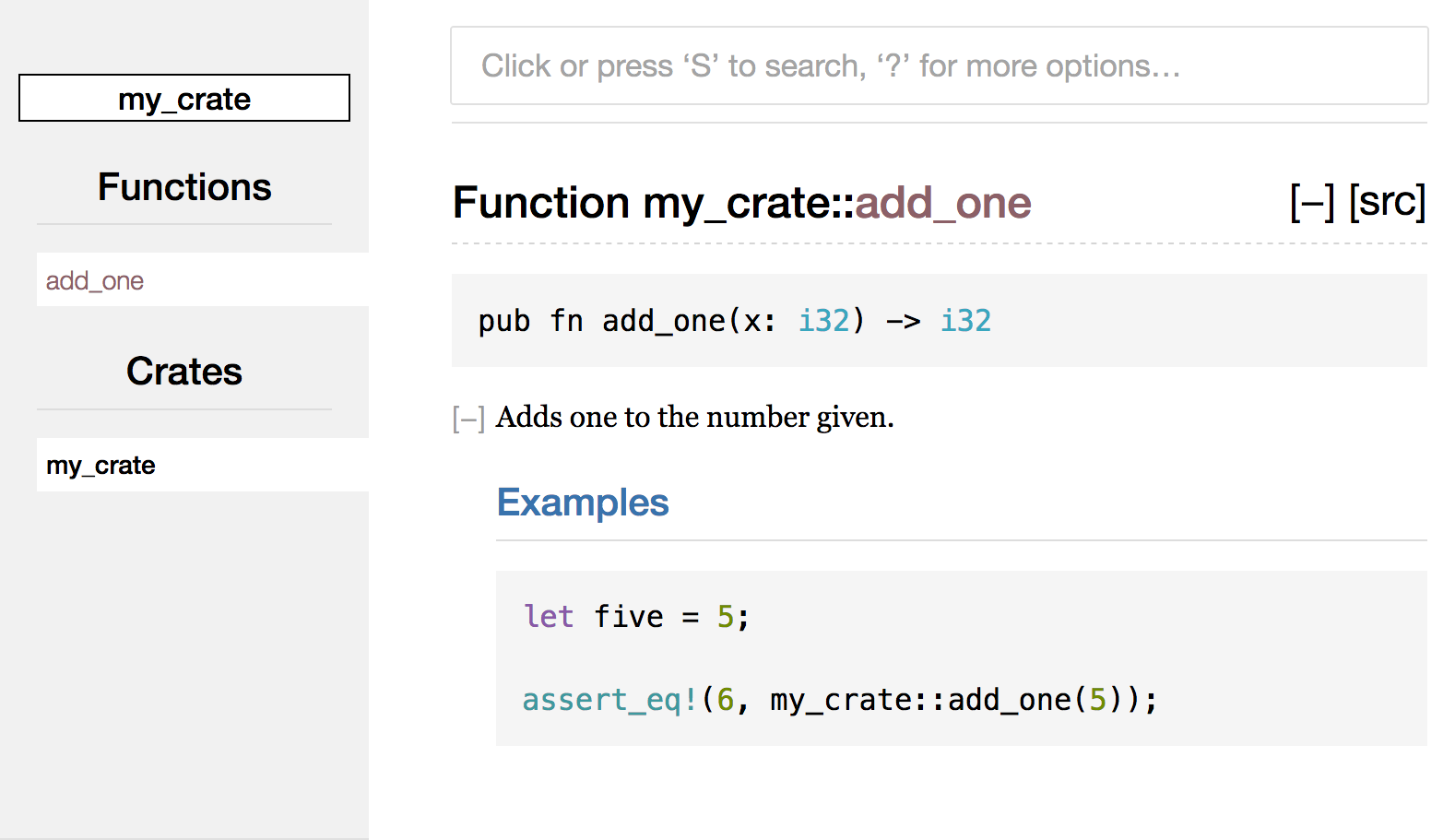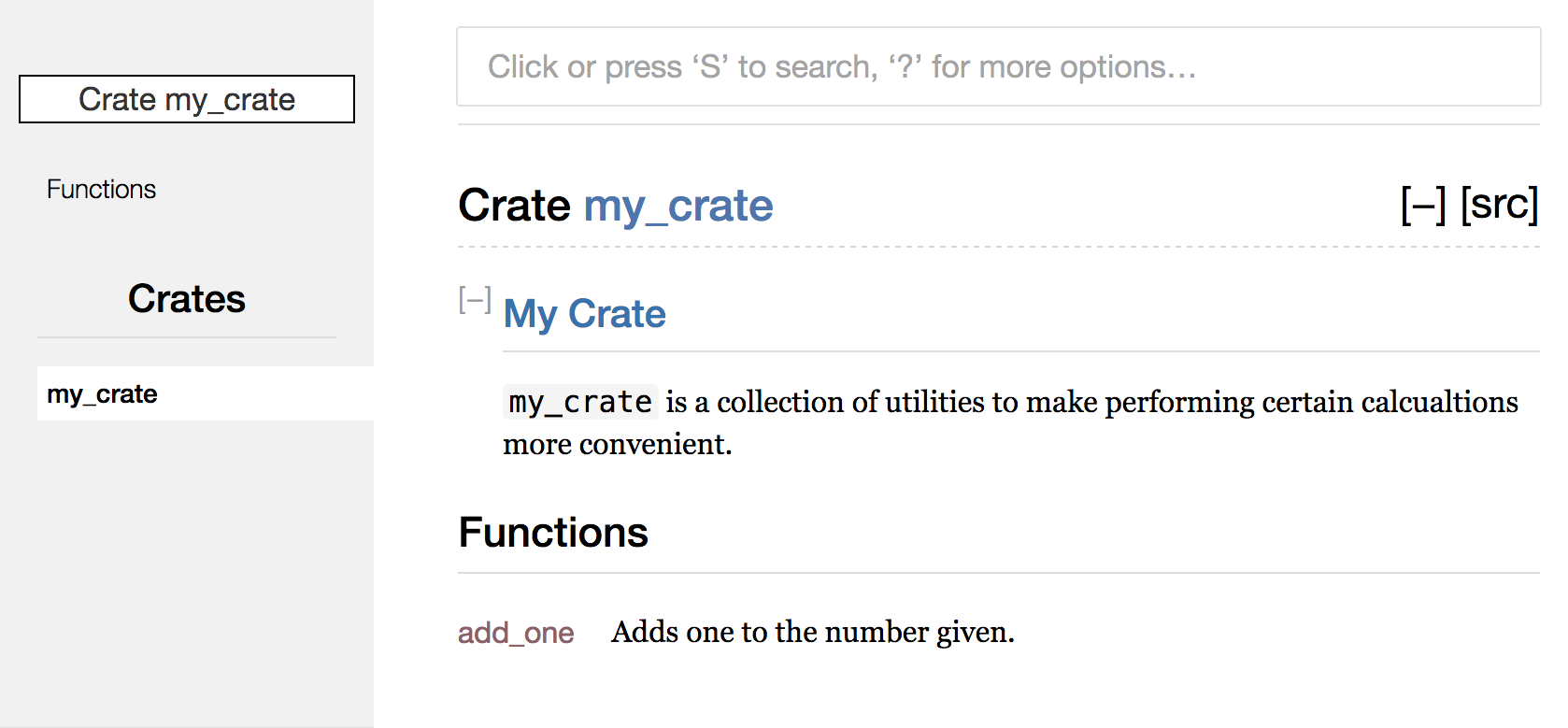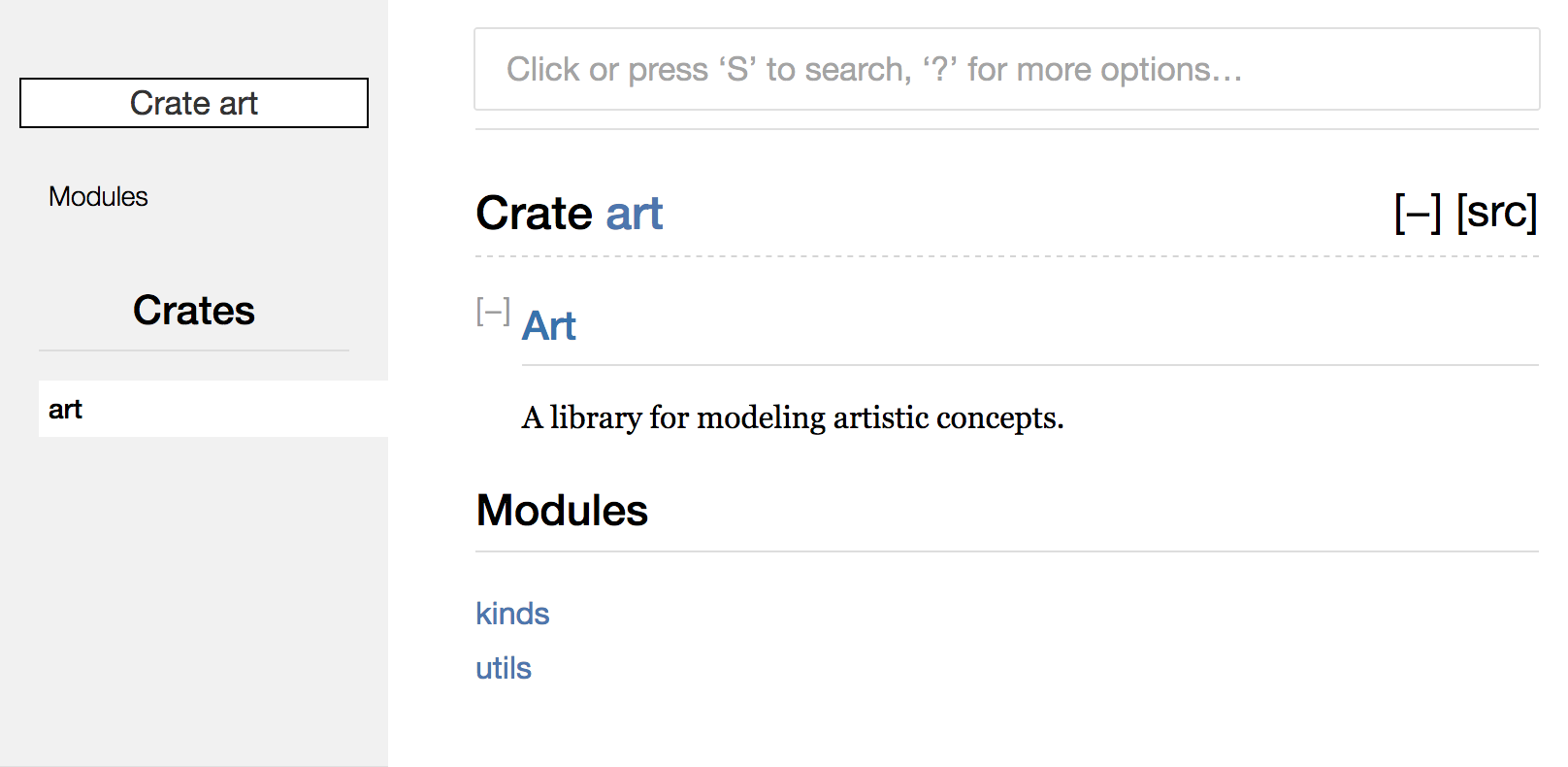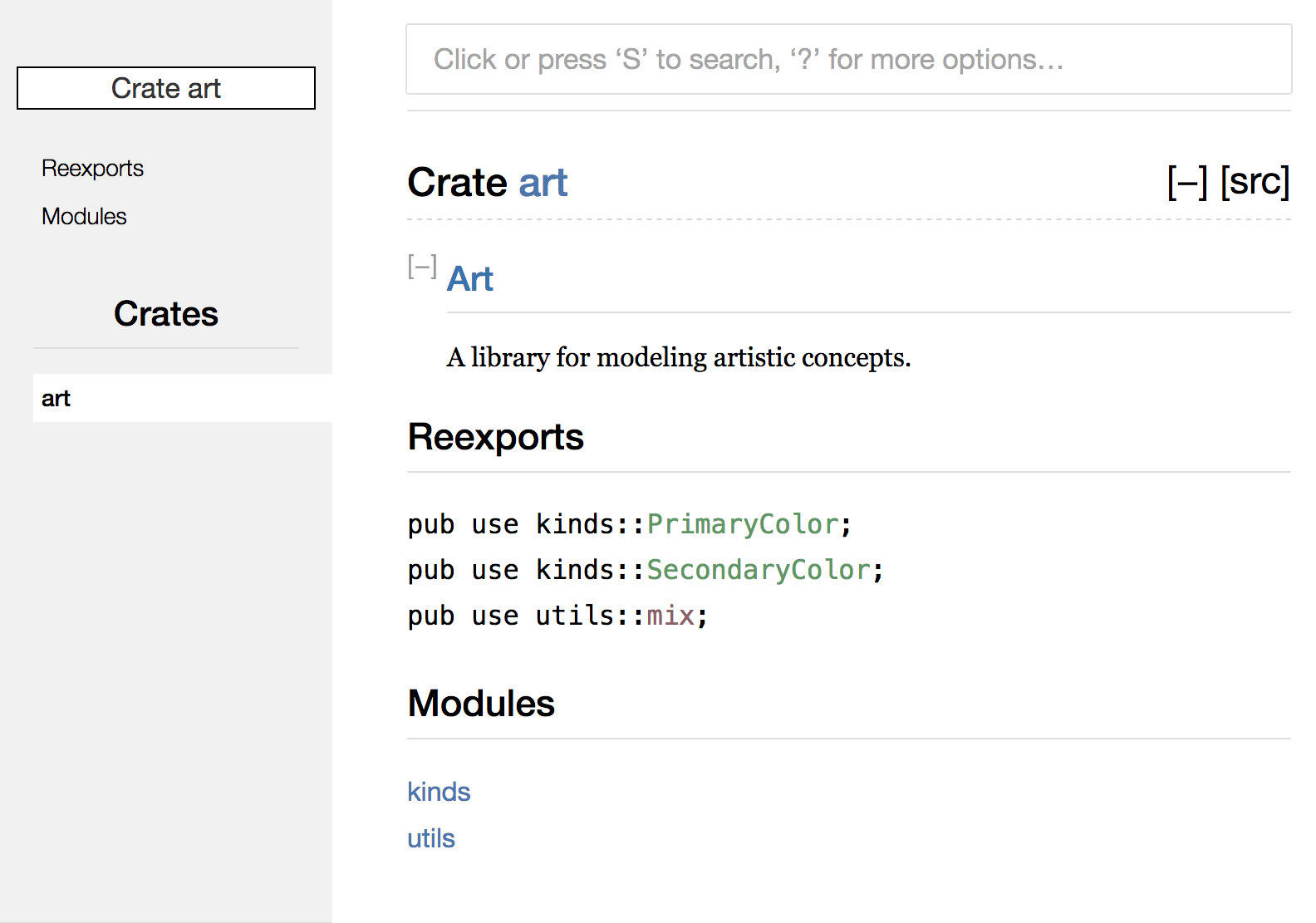Publishing a Crate to Crates.io
We’ve used packages from crates.io as dependencies of our project, but you can also share your code for other people to use by publishing your own packages. Crates.io distributes the source code of your packages, so it primarily hosts code that’s open source.
Rust and Cargo have features that help make your published package easier for people to find and use. We’ll talk about some of those features, then cover how to publish a package.
Making Useful Documentation Comments
Accurately documenting your packages will help other users know how and when to
use them, so it’s worth spending some time to write documentation. In Chapter
3, we discussed how to comment Rust code with //. Rust also has particular
kind of comment for documentation, known conveniently as documentation
comments, that will generate HTML documentation. The HTML displays the
contents of documentation comments for public API items, intended for
programmers interested in knowing how to use your crate, as opposed to how
your crate is implemented.
Documentation comments use /// instead of // and support Markdown notation
for formatting the text if you’d like. You place documentation comments just
before the item they are documenting. Listing 14-2 shows documentation comments
for an add_one function in a crate named my_crate:
Filename: src/lib.rs
/// Adds one to the number given.
///
/// # Examples
///
/// ```
/// let five = 5;
///
/// assert_eq!(6, my_crate::add_one(5));
/// ```
pub fn add_one(x: i32) -> i32 {
x + 1
}
Listing 14-2: A documentation comment for a function
Here, we give a description of what the add_one function does, then start a
section with the heading “Examples”, and code that demonstrates how to use the
add_one function. We can generate the HTML documentation from this
documentation comment by running cargo doc. This command runs the rustdoc
tool distributed with Rust and puts the generated HTML documentation in the
target/doc directory.
For convenience, running cargo doc --open will build the HTML for your
current crate’s documentation (as well as the documentation for all of your
crate’s dependencies) and open the result in a web browser. Navigate to the
add_one function and you’ll see how the text in the documentation comments
gets rendered, shown here in Figure 14-3:

Figure 14-3: HTML documentation for the add_one
function
Commonly Used Sections
We used the # Examples markdown heading in Listing 14-2 to create a section
in the HTML with the title “Examples”. Some other sections that crate authors
commonly use in their documentation include:
- Panics: The scenarios in which this function could
panic!. Callers of this function who don’t want their programs to panic should make sure that they don’t call this function in these situations. - Errors: If this function returns a
Result, describing the kinds of errors that might occur and what conditions might cause those errors to be returned can be helpful to callers so that they can write code to handle the different kinds of errors in different ways. - Safety: If this function uses
unsafecode (which we will discuss in Chapter 19), there should be a section covering the invariants that this function expects callers to uphold in order for the code inunsafeblocks to function correctly.
Most documentation comment sections don’t need all of these sections, but this is a good list to check to remind you of the kinds of things that people calling your code will be interested in knowing about.
Documentation Comments as Tests
Adding examples in code blocks in your documentation comments is a way to
clearly demonstrate how to use your library, but it has an additional bonus:
running cargo test will run the code examples in your documentation as tests!
Nothing is better than documentation with examples. Nothing is worse than
examples that don’t actually work because the code has changed since the
documentation has been written. Try running cargo test with the documentation
for the add_one function like in Listing 14-2; you should see a section in
the test results like this:
Doc-tests my_crate
running 1 test
test src/lib.rs - add_one (line 5) ... ok
test result: ok. 1 passed; 0 failed; 0 ignored; 0 measured
Now try changing either the function or the example so that the assert_eq! in
the example will panic. Run cargo test again, and you’ll see that the doc
tests catch that the example and the code are out of sync from one another!
Commenting Contained Items
There’s another style of doc comment, //!, that adds documentation to the
item that contains the comments, rather than adding documentation to the items
following the comments. These are typically used inside the crate root file
(src/lib.rs) or inside a module’s root (mod.rs) to document the crate or
the module as a whole.
For example, if we wanted to add documentation that described the purpose of
the my_crate crate that contains the add_one function, we can add
documentation comments that start with //! to the beginning of src/lib.rs
as shown in Listing 14-4:
Filename: src/lib.rs
//! # My Crate
//!
//! `my_crate` is a collection of utilities to make performing certain
//! calculations more convenient.
/// Adds one to the number given.
// ...snip...
Listing 14-4: Documentation for the my_crate crate as a
whole
Notice there isn’t any code after the last line that begins with //!. Because
we started the comments with //! instead of ///, we’re documenting the item
that contains this comment rather than an item that follows this comment. In
this case, the item that contains this comment is the src/lib.rs file, which
is the crate root. These comments describe the entire crate.
If we run cargo doc --open, we’ll see these comments displayed on the front
page of the documentation for my_crate above the list of public items in the
crate, as shown in Figure 14-5:

Figure 14-5: Rendered documentation for my_crate
including the comment describing the crate as a whole
Documentation comments within items are useful for describing crates and modules especially. Use them to talk about the purpose of the container overall to help users of your crate understand your organization.
Exporting a Convenient Public API with pub use
In Chapter 7, we covered how to organize our code into modules with the mod
keyword, how to make items public with the pub keyword, and how to bring
items into a scope with the use keyword. The structure that makes sense to
you while you’re developing a crate may not be very convenient for your users,
however. You may wish to organize your structs in a hierarchy containing
multiple levels, but people that want to use a type you’ve defined deep in the
hierarchy might have trouble finding out that those types exist. They might
also be annoyed at having to type use my_crate::some_module::another_module::UsefulType; rather than use my_crate::UsefulType;.
The structure of your public API is a major consideration when publishing a crate. People who use your crate are less familiar with the structure than you are, and might have trouble finding the pieces they want to use if the module hierarchy is large.
The good news is that, if the structure isn’t convenient for others to use
from another library, you don’t have to rearrange your internal organization:
you can choose to re-export items to make a public structure that’s different
to your private structure, using pub use. Re-exporting takes a public item in
one location and makes it public in another location as if it was defined in
the other location instead.
For example, say we made a library named art for modeling artistic concepts.
Within this library is a kinds module containing two enums named
PrimaryColor and SecondaryColor and a utils module containing a function
named mix as shown in Listing 14-6:
Filename: src/lib.rs
//! # Art
//!
//! A library for modeling artistic concepts.
pub mod kinds {
/// The primary colors according to the RYB color model.
pub enum PrimaryColor {
Red,
Yellow,
Blue,
}
/// The secondary colors according to the RYB color model.
pub enum SecondaryColor {
Orange,
Green,
Purple,
}
}
pub mod utils {
use kinds::*;
/// Combines two primary colors in equal amounts to create
/// a secondary color.
pub fn mix(c1: PrimaryColor, c2: PrimaryColor) -> SecondaryColor {
// ...snip...
# SecondaryColor::Green
}
}
Listing 14-6: An art library with items organized into
kinds and utils modules
The front page of the documentation for this crate generated by cargo doc
would look like Figure 14-7:

Figure 14-7: Front page of the documentation for art
that lists the kinds and utils modules
Note that the PrimaryColor and SecondaryColor types aren’t listed on the
front page, nor is the mix function. We have to click on kinds and utils
in order to see them.
Another crate depending on this library would need use statements that import
the items from art including specifying the module structure that’s currently
defined. Listing 14-8 shows an example of a crate that uses the PrimaryColor
and mix items from the art crate:
Filename: src/main.rs
extern crate art;
use art::kinds::PrimaryColor;
use art::utils::mix;
fn main() {
let red = PrimaryColor::Red;
let yellow = PrimaryColor::Yellow;
mix(red, yellow);
}
Listing 14-8: A crate using the art crate’s items with
its internal structure exported
The author of the code in Listing 14-8 that uses the art crate had to figure
out that PrimaryColor is in the kinds module and mix is in the utils
module. The module structure of the art crate is more relevant to developers
working on the art crate than developers using the art crate. The internal
structure that organizes parts of the crate into the kinds module and the
utils module doesn’t add any useful information to someone trying to
understand how to use the art crate. The art crate’s module structure adds
confusion in having to figure out where to look and inconvenience in having to
specify the module names in the use statements.
To remove the internal organization from the public API, we can take the art
crate code from Listing 14-6 and add pub use statements to re-export the
items at the top level, as shown in Listing 14-9:
Filename: src/lib.rs
//! # Art
//!
//! A library for modeling artistic concepts.
pub use kinds::PrimaryColor;
pub use kinds::SecondaryColor;
pub use utils::mix;
pub mod kinds {
// ...snip...
}
pub mod utils {
// ...snip...
}
Listing 14-9: Adding pub use statements to re-export
items
The API documentation generated with cargo doc for this crate will now list
and link re-exports on the front page as shown in Figure 14-10, which makes
these types easier to find.

Figure 14-10: Front page of the documentation for art
that lists the re-exports
Users of the art crate can still see and choose to use the internal structure
as in Listing 14-8, or they can use the more convenient structure from Listing
14-9, as shown in Listing 14-11:
Filename: src/main.rs
extern crate art;
use art::PrimaryColor;
use art::mix;
fn main() {
// ...snip...
}
Listing 14-11: A program using the re-exported items from
the art crate
In cases where there are many nested modules, re-exporting the types at the top
level with pub use can make a big difference in the experience of people who
use the crate.
Creating a useful public API structure is more of an art than a science, and
you can iterate to find the API that works best for your users. Choosing pub use gives you flexibility in how you structure your crate internally, and
decouples that internal structure with what you present to your users. Take a
look at some of the code of crates you’ve installed to see if their internal
structure differs from their public API.
Setting up a Crates.io Account
Before you can publish any crates, you need to create an account on crates.io
and get an API token. To do so, visit the home page at https://crates.io and
log in via a GitHub account---the GitHub account is a requirement for now, but
the site may support other ways of creating an account in the future. Once
you’re logged in, visit your account settings at https://crates.io/me and
retrieve your API key. Then run the cargo login command with your API key,
like this:
$ cargo login abcdefghijklmnopqrstuvwxyz012345
This command will inform Cargo of your API token and store it locally in ~/.cargo/credentials. Note that this token is a secret and should not be shared with anyone else. If it is shared with anyone for any reason, you should revoke it and generate a new token on Crates.io.
Before Publishing a New Crate
Now you have an account, and let’s say you already have a crate you want to
publish. Before publishing, you’ll need to add some metadata to your crate by
adding it to the [package] section of the crate’s Cargo.toml.
Your crate will first need a unique name. While you’re working on a crate
locally, you may name a crate whatever you’d like. However, crate names on
Crates.io are allocated on a first-come-first-serve basis. Once a crate name is
taken, no one else may publish a crate with that name. Search for the name
you’d like to use on the site to find out if it has been taken. If it hasn’t,
edit the name in Cargo.toml under [package] to have the name you want to
use for publishing like so:
[package]
name = "guessing_game"
Even if you’ve chosen a unique name, if you try to run cargo publish to
publish the crate at this point, you’ll get a warning and then an error:
$ cargo publish
Updating registry `https://github.com/rust-lang/crates.io-index`
warning: manifest has no description, license, license-file, documentation,
homepage or repository.
...snip...
error: api errors: missing or empty metadata fields: description, license.
This is because we’re missing some crucial information: a description and license are required so that people will know what your crate does and under what terms they may use it. To rectify this error, we need to include this information in Cargo.toml.
Make a description that’s just a sentence or two, as it will appear with your
crate in search results and on your crate’s page. For the license field, you
need to give a license identifier value. The Linux Foundation’s Software
Package Data Exchange (SPDX) at http://spdx.org/licenses/ lists the
identifiers you can use for this value. For example, to specify that you’ve
licensed your crate using the MIT License, add the MIT identifier:
[package]
name = "guessing_game"
license = "MIT"
If you want to use a license that doesn’t appear in the SPDX, you need to place
the text of that license in a file, include the file in your project, then use
license-file to specify the name of that file instead of using the license
key.
Guidance on which license is right for your project is out of scope for this
book. Many people in the Rust community choose to license their projects in the
same way as Rust itself, with a dual license of MIT/Apache-2.0---this
demonstrates that you can also specify multiple license identifiers separated
by a slash.
So, with a unique name, the version, and author details that cargo new added
when you created the crate, your description, and the license you chose added,
the Cargo.toml for a project that’s ready to publish might look like this:
[package]
name = "guessing_game"
version = "0.1.0"
authors = ["Your Name <you@example.com>"]
description = "A fun game where you guess what number the computer has chosen."
license = "MIT/Apache-2.0"
[dependencies]
Cargo’s documentation describes other metadata you can specify to ensure your crate can be discovered and used more easily!
Publishing to Crates.io
Now that you’ve created an account, saved your API token, chosen a name for your crate, and specified the required metadata, you’re ready to publish! Publishing a crate uploads a specific version to crates.io for others to use.
Take care when publishing a crate, because a publish is permanent. The version can never be overwritten, and the code cannot be deleted. One major goal of Crates.io is to act as a permanent archive of code so that builds of all projects that depend on crates from Crates.io will continue to work. Allowing deletion of versions would make fulfilling that goal impossible. However, there is no limit to the number of versions of a crate you can publish.
Let’s run the cargo publish command again. It should succeed now:
$ cargo publish
Updating registry `https://github.com/rust-lang/crates.io-index`
Packaging guessing_game v0.1.0 (file:///projects/guessing_game)
Verifying guessing_game v0.1.0 (file:///projects/guessing_game)
Compiling guessing_game v0.1.0
(file:///projects/guessing_game/target/package/guessing_game-0.1.0)
Finished dev [unoptimized + debuginfo] target(s) in 0.19 secs
Uploading guessing_game v0.1.0 (file:///projects/guessing_game)
Congratulations! You’ve now shared your code with the Rust community, and anyone can easily add your crate as a dependency of their project.
Publishing a New Version of an Existing Crate
When you’ve made changes to your crate and are ready to release a new version,
you change the version value specified in your Cargo.toml and republish.
Use the Semantic Versioning rules to decide what an appropriate next
version number is based on the kinds of changes you’ve made. Then run cargo publish to upload the new version.
Removing Versions from Crates.io with cargo yank
While you can’t remove previous versions of a crate, you can prevent any future projects from adding them as a new dependency. This is useful when a version of a crate ends up being broken for one reason or another. For situations such as this, Cargo supports yanking a version of a crate.
Yanking a version prevents new projects from starting to depend on that version while allowing all existing projects that depend on it to continue to download and depend on that version. Essentially, a yank means that all projects with a Cargo.lock will not break, while any future Cargo.lock files generated will not use the yanked version.
To yank a version of a crate, run cargo yank and specify which version you
want to yank:
$ cargo yank --vers 1.0.1
You can also undo a yank, and allow projects to start depending on a version
again, by adding --undo to the command:
$ cargo yank --vers 1.0.1 --undo
A yank does not delete any code. The yank feature is not intended for deleting accidentally uploaded secrets, for example. If that happens, you must reset those secrets immediately.